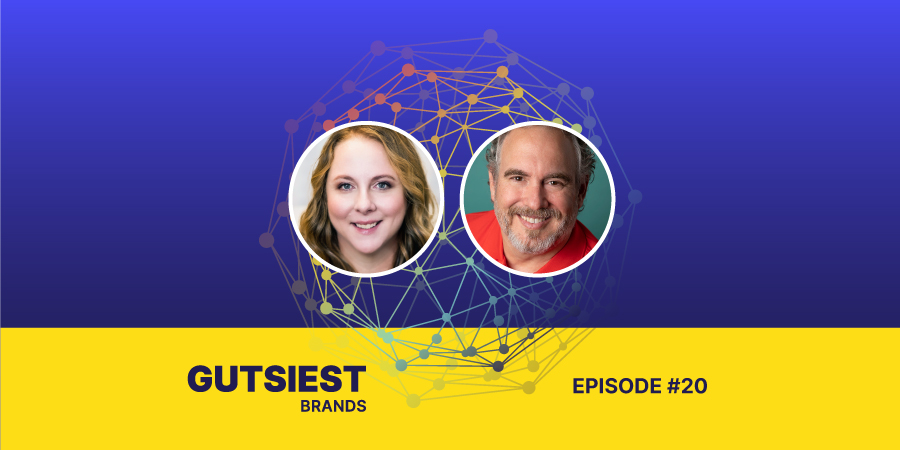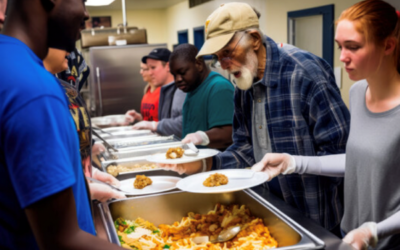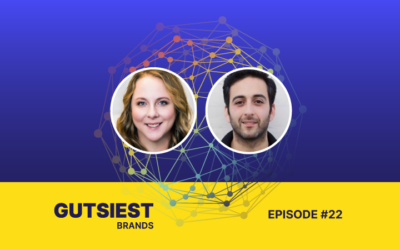
Tell Me More About That with Rob Volpe
(highlights from Episode #20 of the Gutsiest Brands podcast)
Check out the latest lessons from our Gutsiest Brands podcast as GutCheck’s Chief Revenue Officer, Jess Gaedeke, sits down with Rob Volpe, an author and speaker, CEO of Ignite 360, and an Empathy Activist. They talk about the five steps of empathy, why companies should lean into innovation even in uncertain economic times, and how simply asking questions can create more than just a transactional relationship with your client partners.
Rob started his entrepreneurial journey when he was little with a paper route, but he wasn’t an ordinary paper boy. “I loved going around and collecting payments from everybody because I got to go to their homes, and sometimes they’d invite me in. We’d end up having a conversation and get to know one another, and end up talking about our lives, rituals, holiday traditions, politics, and family. I realize now, as an adult, ‘wow, I was doing ethnographic interviews, deep dives, at a really early age,’ and I absolutely loved that.”
This spirit of getting to know people at a deeper level eventually led Rob to the world of insights and qualitative research where it all came together for him, and he started Ignite 360, a full-service insight, strategy, and training firm. They focus on qualitative and quantitative research to connect companies with empathetic insights through storytelling.
Here’s what Rob says about empathy and business…
Takeaway #1 – Be an Empathy Activist
“Through the course of my professional journey, the role of empathy has just always been a strong personal value and sort of superpower of mine,” says Rob. “But being in the insights world, I noticed that disconnect so many people have when they are faced with people that are ‘other.’” Rob says this “otherness” can work in favor of marketers because the makers of the products are often not the consumers. By embracing others, we are showing empathy. It’s not always easy for companies to harness this information, but Rob stresses, “Empathy is part of insights, and if you don’t have empathy with your consumer, yes you can go about making a new product, a service, an offering, an ad campaign – but it’s not going to ring and connect. Truly, it’s going to ring hollow and false.”
Takeaway #2 – Stories Bring the Impact
When starting his author journey, Rob knew he wanted to bring information to readers in a new way. “I had the idea for the book and the topic of empathy, but I was looking at the books that were out there, and I decided, I don’t really want to write a business book. I want to write a book that people are going to want to read and that they’re going to be entertained by. You learn through stories and the entertainment element. Those things stick with you in a much deeper way than the didactic learning that you might go through with some of the business books that are out there.” Rob decided the only way to do that was to get personal. “Using story became a key component to the book, and it was important to me when I was talking to publishers that they understood that I was filling the book with my own experiences, my failures. When I’m telling stories about me and things that are relatable, then people do engage with it. And so it was very clear, I want to write a book that people are going to want to read.”
Takeaway #3 – Five Steps of Empathy
Rob says as an Empathy Activist, he “set out on a mission to demystify empathy for people.” He breaks empathy into five important steps: “The first one is dismantle your judgment. Second one is to ask good questions. Third is to actively listen. Fourth is to integrate into understanding. And the fifth one is to use solution imagination.” Some of these steps are more difficult than others. “What I’ve found, and we have a little bit of data to back this up, is that first step, dismantling your judgment, is the one that gets in most people’s way.” For more information on the five steps to empathy, check out Rob’s book, Tell Me More About That: Solving the Empathy Crisis One Conversation at a Time (www.5stepstoempathy.com).
Takeaway #4 – Focus on the Future (But also Here and Now)
It’s important to focus on the present while also future-proofing your company. “I think there’s a mix of clients that are focused on the here and now. And, in some cases, they’ve got crazy supply chain disruptions or whatever. However, even then, you can’t stop innovating. You can’t stop thinking about the future.” Rob reminds us that even agile companies are thinking six months to eighteen months ahead from concept to complete product or service. “Imagine that when we get through whatever this uncertainty economically is, your pipeline is just you, no pipeline. So now you’ve weathered a recession, but then you’ve got a trickle in terms of really growing and meeting the shifting needs of your consumers, and you’re just going to have to start all over again whenever that period comes. So, you have to continue to always lean in and innovate. You can’t take your eye off the here and now of the business, but you’ve also got to be thinking about the future and where that can lead.”
Takeaway #5 – Tackling Inclusivity
If you want your marketing to be inclusive, it’s got to start from the top down. “The organization has to make the commitment to do that and then be open to having the conversations and asking the right questions – asking the right questions to the right people, and also by the right people as well so that you can really get that deeper understanding.” Rob has seen every marketing trend since the 90s, but says, “what’s hopefully different now is this understanding that this isn’t just some other group that we put into a box, but really, how do you understand all the different nuances and the intersectionality of things and find the commonalities and the relevance for your brand and your campaign or the products that you’re going to do? You need to make sure that you are representing who your consumers actually are, and not just defaulting to the people that look just like me.” Rob says it’s imperative to build connections and find similarities as a foundation, and then start to be curious and have conversations. “Once you understand that we are all more similar than we are different, you can start there. And then, as you come across the differences, it gives you an opportunity to better understand them.”
Rob‘s Best Advice?
Live like Rosalind Russell in the 1958 movie Auntie Mame. Why? “Auntie Mame, her statement about life and one of the key messages in the movie is you’ve got to live. Life is a banquet, and most poor suckers are starving to death. And that’s just been something in my life and in my career that I’ve really taken to heart and tried to practice. I’ve been in marketing since 1995. I’ve been in PR. I’ve done promotional marketing, marketing communications, partnership marketing, grassroots marketing. And then I got into insights, and I’ve been in insights for fifteen years. I have sampled from the banquet, from the buffet table, and I’m better for that because I’m able to draw from all of those experiences and put those into play, just as with Auntie Mame – it’s made her a much more worldly individual and she’s learned so much and has so many different perspectives.”
And of course, have empathy. “It’s really critical to make the world a better place, one conversation at a time.”
Keep Learning
Catch up on Jess and Rob’s full interview by listening to the Gutsiest Brands podcast. If you are interested in how your brand can uncover the deep customer insights that can enable you to lead with empathy, pioneer new paths, stand behind bold ideas, and lean into ‘the power of AND’, we’d love to help. Drop us a note!
Written By
Want to stay up to date on the latest GutCheck blog posts?
Check Out Our Most Recent Blog Posts
When Vocation and Avocation Collide
At GutCheck, we have four brand pillars upon which we build our business. One of those is to 'lead...
Reflections on Season 1 of Gutsiest Brands
Understanding people is at the heart of market research. Sure, companies want to know what ideas...
Permission to Evolve with Miguel Garcia Castillo
(highlights from Episode #22 of the Gutsiest Brands podcast) Check out the latest lessons from our...
1-877-990-8111
[email protected]
© 2023 GutCheck is a registered trademark of Brainyak, Inc. All rights reserved.
© 2020 GutCheck is a registered trademark of Brainyak, Inc. All rights reserved.



